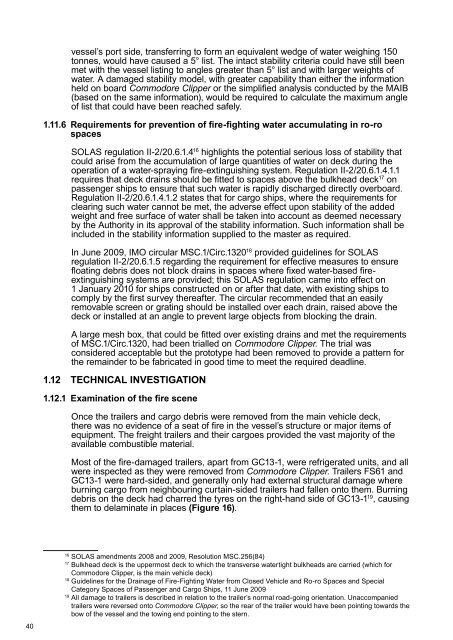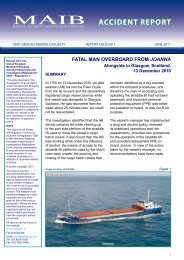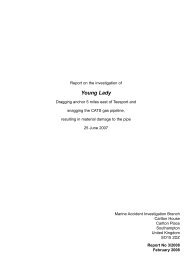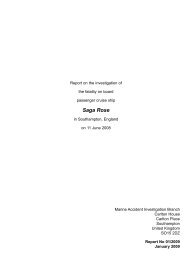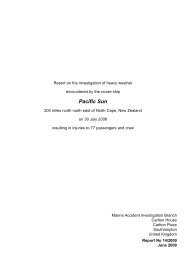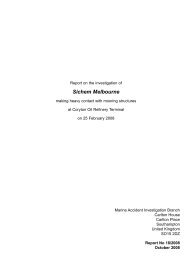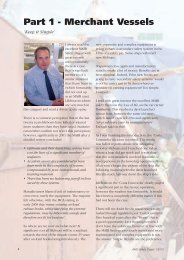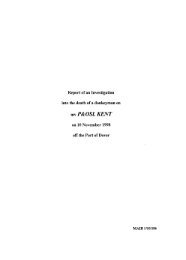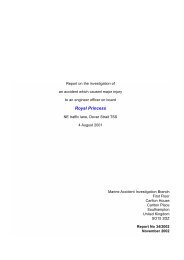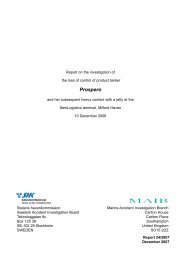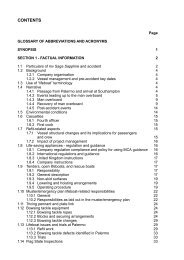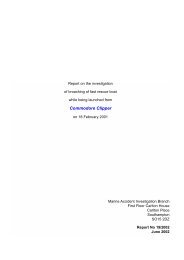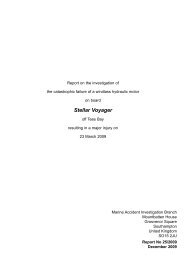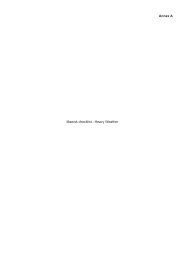Commodore Clipper - Marine Accident Investigation Branch
Commodore Clipper - Marine Accident Investigation Branch
Commodore Clipper - Marine Accident Investigation Branch
Create successful ePaper yourself
Turn your PDF publications into a flip-book with our unique Google optimized e-Paper software.
40<br />
vessel’s port side, transferring to form an equivalent wedge of water weighing 150<br />
tonnes, would have caused a 5° list. The intact stability criteria could have still been<br />
met with the vessel listing to angles greater than 5° list and with larger weights of<br />
water. A damaged stability model, with greater capability than either the information<br />
held on board <strong>Commodore</strong> <strong>Clipper</strong> or the simplified analysis conducted by the MAIB<br />
(based on the same information), would be required to calculate the maximum angle<br />
of list that could have been reached safely.<br />
1.11.6 Requirements for prevention of fire-fighting water accumulating in ro-ro<br />
spaces<br />
SOLAS regulation II-2/20.6.1.4 16 highlights the potential serious loss of stability that<br />
could arise from the accumulation of large quantities of water on deck during the<br />
operation of a water-spraying fire-extinguishing system. Regulation II-2/20.6.1.4.1.1<br />
requires that deck drains should be fitted to spaces above the bulkhead deck 17 on<br />
passenger ships to ensure that such water is rapidly discharged directly overboard.<br />
Regulation II-2/20.6.1.4.1.2 states that for cargo ships, where the requirements for<br />
clearing such water cannot be met, the adverse effect upon stability of the added<br />
weight and free surface of water shall be taken into account as deemed necessary<br />
by the Authority in its approval of the stability information. Such information shall be<br />
included in the stability information supplied to the master as required.<br />
In June 2009, IMO circular MSC.1/Circ.1320 18 provided guidelines for SOLAS<br />
regulation II-2/20.6.1.5 regarding the requirement for effective measures to ensure<br />
floating debris does not block drains in spaces where fixed water-based fireextinguishing<br />
systems are provided; this SOLAS regulation came into effect on<br />
1 January 2010 for ships constructed on or after that date, with existing ships to<br />
comply by the first survey thereafter. The circular recommended that an easily<br />
removable screen or grating should be installed over each drain, raised above the<br />
deck or installed at an angle to prevent large objects from blocking the drain.<br />
A large mesh box, that could be fitted over existing drains and met the requirements<br />
of MSC.1/Circ.1320, had been trialled on <strong>Commodore</strong> <strong>Clipper</strong>. The trial was<br />
considered acceptable but the prototype had been removed to provide a pattern for<br />
the remainder to be fabricated in good time to meet the required deadline.<br />
1.12 TECHNICAL INVESTIGATION<br />
1.12.1 Examination of the fire scene<br />
Once the trailers and cargo debris were removed from the main vehicle deck,<br />
there was no evidence of a seat of fire in the vessel’s structure or major items of<br />
equipment. The freight trailers and their cargoes provided the vast majority of the<br />
available combustible material.<br />
Most of the fire-damaged trailers, apart from GC13-1, were refrigerated units, and all<br />
were inspected as they were removed from <strong>Commodore</strong> <strong>Clipper</strong>. Trailers FS61 and<br />
GC13-1 were hard-sided, and generally only had external structural damage where<br />
burning cargo from neighbouring curtain-sided trailers had fallen onto them. Burning<br />
debris on the deck had charred the tyres on the right-hand side of GC13-1 19 , causing<br />
them to delaminate in places (Figure 16).<br />
16 SOLAS amendments 2008 and 2009, Resolution MSC.256(84)<br />
17 Bulkhead deck is the uppermost deck to which the transverse watertight bulkheads are carried (which for<br />
<strong>Commodore</strong> <strong>Clipper</strong>, is the main vehicle deck)<br />
18 Guidelines for the Drainage of Fire-Fighting Water from Closed Vehicle and Ro-ro Spaces and Special<br />
Category Spaces of Passenger and Cargo Ships, 11 June 2009<br />
19 All damage to trailers is described in relation to the trailer’s normal road-going orientation. Unaccompanied<br />
trailers were reversed onto <strong>Commodore</strong> <strong>Clipper</strong>, so the rear of the trailer would have been pointing towards the<br />
bow of the vessel and the towing end pointing to the stern.


